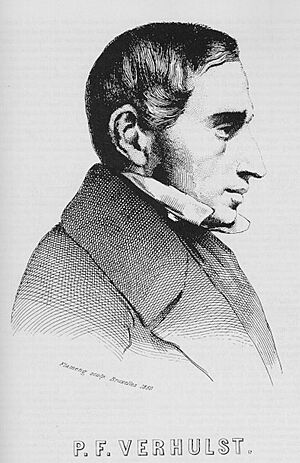Pierre François Verhulst facts for kids
Pierre François Verhulst (born October 28, 1804, died February 15, 1849) was a smart mathematician from Brussels, Belgium. He earned his degree in number theory from the University of Ghent in 1825. He is most famous for creating a special math model called the logistic growth model, which helps us understand how populations grow.
Understanding Population Growth
Pierre François Verhulst spent time studying how populations of living things, like animals or people, grow. He realized that populations don't just keep growing bigger and bigger forever. There's usually a limit to how many individuals an environment can support.
The Logistic Model
Verhulst developed his important idea, called the logistic function, between 1838 and 1847. He worked on this with guidance from another scientist named Adolphe Quetelet.
His model showed that population growth often follows an "S-shaped" curve.
- At first, a population might grow very quickly.
- But as it gets larger, things like limited food, space, or resources start to slow down the growth.
- Eventually, the population reaches a maximum size that the environment can handle. This limit is often called the carrying capacity. It's like the maximum number of people a school bus can hold.
Verhulst's logistic model helps scientists predict how populations will change over time. It shows how a population grows fast when it's small, then slows down as it gets closer to the carrying capacity.
Later, other scientists named Raymond Pearl and Lowell Reed also helped make this idea popular. The logistic model is still used today to study many things, from how animals spread in a new area to how diseases might spread through a group of people. It helps us understand the balance between growth and limits in nature.
See also
 In Spanish: Pierre-François Verhulst para niños
In Spanish: Pierre-François Verhulst para niños
- Population dynamics
- Logistic map
- Logistic distribution


